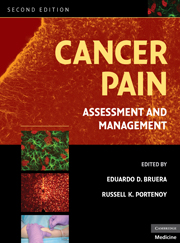Book contents
- Frontmatter
- Contents
- Contributors
- Preface
- SECTION I MECHANISMS AND EPIDEMIOLOGY
- SECTION II EPIDEMIOLOGY AND SYNDROMES
- SECTION III ASSESSMENT
- SECTION IV PHARMACOLOGICAL TREATMENT
- 9 Pharmacology of analgesia: basic principles
- 10 Pharmacogenetic considerations in the treatment of cancer pain
- 11 Pharmacology of opioid analgesia: clinical principles
- 12 Opioid side effects and management
- 13 Antipyretic analgesics
- 14 Adjuvant analgesic drugs
- 15 Neuraxial analgesia
- SECTION V OTHER INTERVENTIONAL STRATEGIES
- SECTION VI REHABILITATION AND PSYCHOLOGICAL INTERVENTIONS
- SECTION VII THE ROLE OF ANTINEOPLASTIC THERAPIES IN PAIN CONTROL
- SECTION VIII PAIN IN SPECIAL POPULATIONS
- SECTION IX DIFFICULT PAIN PROBLEMS
- SECTION X SYSTEMS OF CARE
- Index
- Plate section
- References
11 - Pharmacology of opioid analgesia: clinical principles
from SECTION IV - PHARMACOLOGICAL TREATMENT
Published online by Cambridge University Press: 06 July 2010
- Frontmatter
- Contents
- Contributors
- Preface
- SECTION I MECHANISMS AND EPIDEMIOLOGY
- SECTION II EPIDEMIOLOGY AND SYNDROMES
- SECTION III ASSESSMENT
- SECTION IV PHARMACOLOGICAL TREATMENT
- 9 Pharmacology of analgesia: basic principles
- 10 Pharmacogenetic considerations in the treatment of cancer pain
- 11 Pharmacology of opioid analgesia: clinical principles
- 12 Opioid side effects and management
- 13 Antipyretic analgesics
- 14 Adjuvant analgesic drugs
- 15 Neuraxial analgesia
- SECTION V OTHER INTERVENTIONAL STRATEGIES
- SECTION VI REHABILITATION AND PSYCHOLOGICAL INTERVENTIONS
- SECTION VII THE ROLE OF ANTINEOPLASTIC THERAPIES IN PAIN CONTROL
- SECTION VIII PAIN IN SPECIAL POPULATIONS
- SECTION IX DIFFICULT PAIN PROBLEMS
- SECTION X SYSTEMS OF CARE
- Index
- Plate section
- References
Summary
Introduction
According to the World Health Organization (WHO) guidelines, opioid analgesics are the mainstay of analgesic therapy and are classified according to their ability to control mild to moderate pain (codeine, dihydrocodeine, tramadol, dextropropoxyphene [DPP]) (second step of the WHO analgesic ladder) and to control moderate to severe pain (morphine, methadone, oxycodone, buprenorphine, hydromorphone, fentanyl, heroin, levorphanol, oxymorphone) (third step of the WHO analgesic ladder). Opioid analgesics may be associated with nonopioid drugs such as paracetamol or with nonsteroidal anti-inflammatory drugs (NSAIDs) and to adjuvant drugs.
The current recommended management of cancer pain consists of the regular administration of opioids and intermittent rescue doses of opioids or NSAIDs for excess pain.
Individualized pain management should take into account the onset, type, site, duration, intensity, and temporal patterns of the pain (from this, it is often possible to define the cause of the pain), concurrent medical conditions, and, above all, the subjective perception of the intensity of pain that is not proportional to the type or to the extension of the tissue damage but depends on the interaction of physical, cultural, and emotional factors.
Oral opioid administration remains the preferred route. However, in some clinical situations, such as vomiting, dysphagia, or confusion, or in cases in which rapid dose escalation is necessary, oral administration may be impossible, and alternative routes must be implemented. Table 11.1 shows the potential application of the different routes of opioid administration in clinical practice.
- Type
- Chapter
- Information
- Cancer PainAssessment and Management, pp. 195 - 229Publisher: Cambridge University PressPrint publication year: 2009
References
- 3
- Cited by



